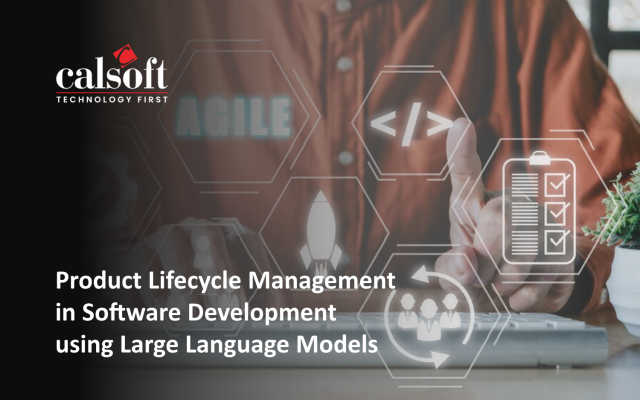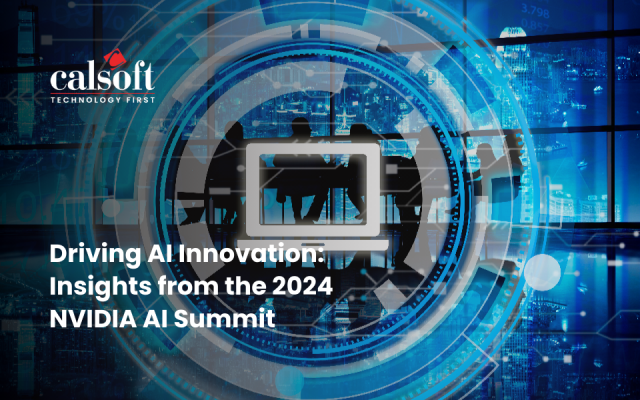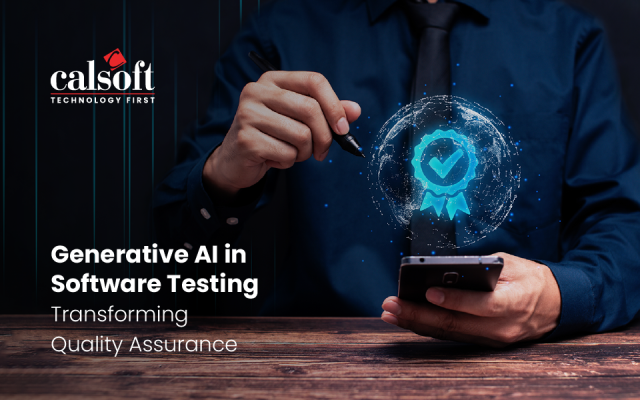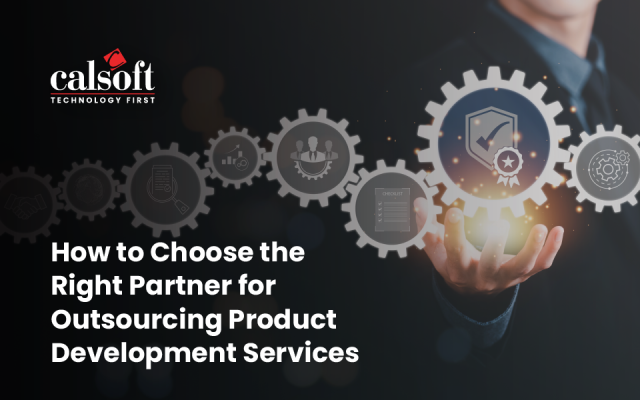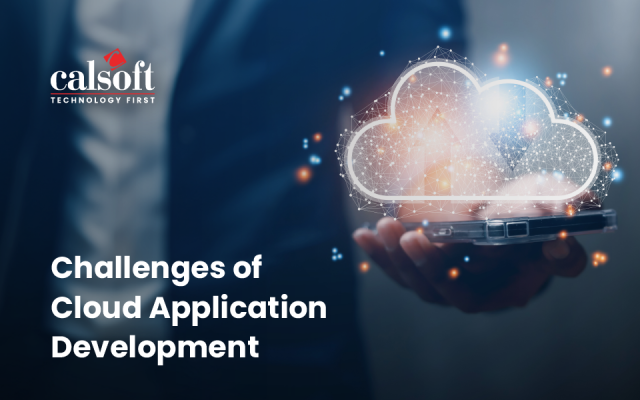The rapid evolution of the technology landscape emphasizes the need for agility, flexibility, and efficiency in software development across businesses. Integrating Artificial Intelligence (AI) with software development is essential to enable this transformation by incorporating operational efficiency and accuracy. Additionally, AI is envisioned as a pioneering solution to accelerate innovative software deployments. The AI domain includes a subset called Generative AI (Gen AI), which fuels the Software Development Lifecycle (SDLC) transformation.
According to research by Fortune Business Insights, the Global Gen AI market of SDLC is expected to grow from $341.3 million in 2023 to 2,833.9 million by 2030, displaying a CAGR of 35.3% during the 7-year forecast period.
This surge is driven by the increasing demand for automation and efficiency in software development processes. GenAI tools are being utilized to automate repetitive coding tasks, enhance code quality, and accelerate development timelines.
So yes! Gen AI in the software development life cycle realm shows great potential by providing transformative opportunities to developers to minimize code generation errors. At the same time, it accelerates the delivery of software products/solutions and dramatically reduces time to market.
Generative AI is getting a lot of recognition because of its key influence on SDLC. Gen AI indicates a set of AI models leveraging deep learning algorithms to identify patterns and create code to realize real-time decision-making and task automation. However, the amalgamation of Gen AI with SDLC presents advantages as well as challenges. Read the blog to explore different facets of Gen AI in SDLC.
Before we dive into the good Gen AI can bring to the software development life cycle, let’s begin with one step at a time and primarily understand and decode conventional SDLC.
The typical SDLC consists of the following stages:
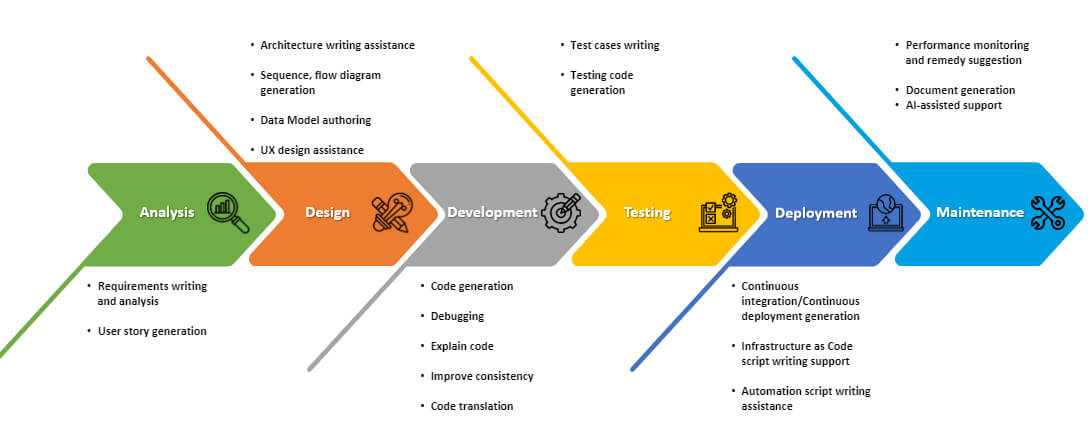
This image talks about the six phases of the software development life cycle, that can be segregated as: Design, Development, Testing, Deployment, and Maintenance. Each phase highlights key tasks, such as requirement analysis, architecture writing, code generation, testing, deployment automation, and ongoing performance monitoring, emphasizing AI and automation assistance throughout the process.
Six Stages of the SDLC Demystified
Planning: This primary stage gathers, evaluates, and records the project requirements. A project plan is made by the team specifying the project scope, cost, and resources needed.
Design: The comprehensive software design is developed during this stage. The design indicates the software design framework, modules, and interfaces. The team also designs a trial product or a replica of the user interface.
Development: This stage develops the software system; actual coding happens at this stage. With the help of programming languages, tools, or frameworks, software modules are generated and combined into a working technique. GenAI supports context-aware code generation, reducing errors and speeding up development.
Tools such as GitHub Copilot help developers by indicating code extracts and finishing lines of code based on contextual interpretation. This saves time and enhances the quality.
Testing: The testing stage checks for faults, errors, or bugs in the software system. The testing team sets up test cases and executes those to identify any faults and communicate them to the development team. The testing can be automated or performed manually.
Generative AI is enabling shift-left testing in the SDLC, ensuring higher-quality code from the outset.
Maintenance: In this stage, the software system deployment is complete in the production environment and is available for the end-users. The development team is responsible for maintaining, supporting, observing, and fixing bugs, and performing regular updates to the system.
Generative AI is enabling seamless integration with cloud platforms like AWS, Azure, and Google Cloud, optimizing deployment processes.
However, these phases in SDLC often encounter certain challenges. The key challenges need to be understood to appropriately leverage the capabilities of GenAI to enhance the conventional approach to software development.
One of the significant challenges is the time and work involved in developing and testing software. The completion of software development projects can extend for months or years, and the testing part single-handedly exhausts a substantial volume of time and resources. As the software development project includes various participants such as developers, testers, managers, and more, a challenge exists in managing and collaborating with these teams.
The success of the project lies in the successful communication and teamwork among these participants. The project progress, timelines, and cost should be continuously monitored to ensure good quality product release. As software systems are complex, there can be scenarios where some faults go unnoticed till it is deployed in the production environment. Project managers are responsible for persistently observing and supervising the project’s development and regulating the plan to finish the project on time and within the estimated budget.
Impact of Gen AI on SDLC
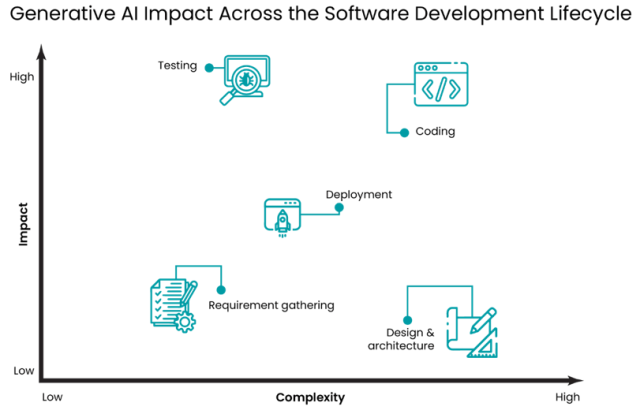
This image is a reference taken from the Everest Group and represents different stages or components of the software development lifecycle, plotted against two axes: “Impact” and “Effort.” The stages shown might include planning, code development, testing, and deployment, arranged to highlight varying levels of effort and the corresponding impact on the overall process, emphasizing optimization or prioritization strategies.
Now that we have a fair idea about the SDLC phases, let us quickly with the help of the table find out how Gen AI leaves an impact on every stage of the SDLC, versus the traditional process.
| Stage | Traditional Process | Generative AI Impact |
| Requirement Analysis | Manually gathering and interpreting user requirements | AI predicts requirements from historical data and user behavior patterns |
| System Design | Architects develop high-level designs from scratch | AI-assisted generation of architectural blueprints and system designs |
| Coding and Implementation | Writing code line-by-line and optimizing manually | Generative AI can auto-generate code, refactor, and optimize based on input |
| Testing and debugging | Creating manual test cases and identifying bugs | AI-generated test cases and automatic bug detection accelerate the testing process |
| Deployment | Manual setup and deployment in stages | AI streamlines deployment by automating CI/CD pipelines and reducing human errors |
| Maintenance and Monitoring | Regularly monitoring and fixing issues post-deployment | AI proactively predicts and resolves potential issues through predictive maintenance |
| Code Documentation | Developers manually create documentation for code structure, functions, and variables. This can be time-consuming and prone to inconsistencies. | Gen AI enables automatic document generation where Gen AI tools analyze code structures, variables, functions, and dependencies to generate detailed documentation. |
By breaking down each stage, we can see the contrast between traditional approaches and how Generative AI enhances and accelerates each process in SDLC. It brings automation, efficiency, and predictability, ensuring better outcomes for software development projects.
Top Seven Benefits of Generative AI in Software Development
Now, let’s delve into how integrating GenAI brings benefits to SDLC. The incorporation of Generative AI in SDLC transforms how software is planned, developed, and delivered, reinventing the tasks for developers, testers, and machines.
Faster and More Accurate User Stories
GenAI streamlines the creation of user stories by breaking down complex requirements into manageable tasks, significantly reducing the time teams spend on this process. It can quickly translate intricate features into clear, actionable user stories, complete with well-defined acceptance criteria. This not only accelerates the planning phase but also ensures accuracy, enabling teams to focus more on development and less on administrative work.
Innovation and Creativity: Automating Code Creation
Gen AI can automate repetitive tasks or code-generation processes. This is achieved using machine learning or deep learning algorithms which help developers build and execute functional codes. This saves time in the development process and enables developers to focus on complicated tasks. In addition, Gen AI analyses massive datasets to detect and fix faults in code. This analysis phase automatically analyses huge datasets, utilizing generative models, to recognize patterns and probable threats or issues. This in turn improves the accuracy of project specification and requirement details.
Enhanced Software Testing and Quality Assurance
Gen AI automates the testing phase and enhances the quality of the software product. Generative models can easily identify any anomalies or threats, enhancing the quality of product and reducing the effort and time in the testing phase. The automated test cases and scripts speed up the process significantly. This ensures comprehensive testing coverage and enables faster identification of defects. With generative AI, developers can expect more efficient and effective software testing, leading to higher-quality products in less time.
CalTIA by Calsoft is a transformative AI-powered test intelligence platform engineered to improve the efficiency of test cycles and elevate the overall quality of the product along with accelerated time to market. Download the brochure to explore how CalTIA streamline workflows and optimize end-to-end testing.
Automatic Generation of Wireframes
Generative AI streamlines the creation of wireframes by taking in feature requirements and context to automatically produce design layouts. This not only accelerates the development process but also ensures that design prototypes are aligned with project specifications from the start. By automating this step, teams can focus on refining the user experience and overall functionality, speeding up the design phase, and contributing to a more efficient SDLC.
Improved Customer Experience
As Gen AI enhances the software quality, in turn this leads to a better user experience and reduced cost of software development. Gen AI generates UI prototypes, proposes the right design elements, and even provides blueprint suggestions supporting users’ demands.
Faster Product Development: Modernizing Project Management and Teamwork
AI models help automate operations or deployments and the seamless shifts from development to production environment. For instance, Gen AI can automatically attribute work to team members depending on their skill sets, saving time and work in project coordination. Besides, Gen AI can accelerate the SDLC by generating models of novel software, to support developers in the development process. This leads to faster Time-To-Market (TTM), and a better insight into user requirements. Generative AI is enhancing Agile and DevOps practices by automating sprint planning and continuous integration/continuous deployment (CI/CD) pipelines.
Rapid, Granular Troubleshooting
GenAI enables rapid and precise troubleshooting by comparing expected outcomes with actual results to identify the root cause of issues more efficiently. It can streamline the process by automating tasks such as upgrading software libraries and re-platforming applications to newer environments. This minimizes manual intervention, reduces errors, and ensures that systems remain up to date with the latest technologies. GenAI’s ability to quickly pinpoint discrepancies and implement fixes enhances operational agility, significantly improving both system performance and reliability.
However, if you are focused on delivering flawless products in the market, our blog on Generative AI in Software Testing: Transforming Quality Assurance is a must read.
Additionally, it is essential to understand that tools play a vital role in seamless development of software products. However, making the right choice is the key. The following table displays a list of tools that can be utilized to achieve the above benefits.
| Gen AI Benefits in SDLC | Key Tools |
| Automated Code Generation | Kite and tabnine |
| Quality Assurance and Software Testing | DeepCode |
| Project Management and Collaboration | Notion AI, Jira, and Trello |
| Natural Language Processing (NLP) and Code Generation | TensorFlow and PyTorch, GitHub Copilot |
Source: GoRetro
Roadblocks that Hinder Scaling up of Gen AI in Software Development
The outcomes of Gen AI in almost every industry are mind-blowing. But is it a cakewalk to implement this powerful technology to start reaping its benefits? Well, like every other technology, the implementation of Gen AI in software development can be a bit challenging. But as it is said, well begun is half done, it is essential to make sure that you are aware of the shortcomings beforehand to be able to make the most of technology in the best possible way.
The integration of Gen AI, special Large Language Models, into the software development process brings forth several opportunities to improve innovation and productivity. Given the results Gen AI can deliver, it is equally essential for technology leaders to navigate the challenges that are likely to arise from using these powerful tools. This section exclusively takes care of the key challenges associated with using generative AI in software development and provides practical strategies for winning over these obstacles, drawing on real-world examples.
While GenAI offers a compelling benefit, it is important to acknowledge the potential challenges that need to be addressed for successful integration. So, let’s begin:
- Technical Expertise: GenAI is a hardcore technology and implementing it on an organizational level, or in important processes such as software development demands specialized skills. The rate at which this technology is being embraced by businesses, not only specialized skills but a suitable infrastructure is something businesses need to invest in.However, to be able to make the most of this technology, businesses need to invest in training or get new talent to harness the full potential of this technology called, Gen AI.
- Integration with legacy systems: Integrating GenAI with legacy systems can pose significant challenges, especially when those systems rely on outdated technologies or lack thorough documentation. The complexity increases as legacy systems may not be designed to support modern AI capabilities, requiring extensive customization, code refactoring, or middleware solutions to ensure seamless compatibility.Furthermore, understanding the intricacies of older systems, which might lack clear documentation, demands significant time and expertise, making the integration process both technically demanding and resource intensive. These hurdles can slow down the implementation of AI and complicate its ability to work efficiently within an existing infrastructure.
- Data privacy: Ensuring data privacy and regulatory compliance is critical when using GenAI models trained on sensitive user data. Organizations must implement strict data governance frameworks to safeguard personal information, ensuring adherence to global data protection laws like GDPR or CCPA. GenAI models, if not properly managed, can unintentionally expose private data or violate legal requirements.This makes it essential to establish transparent data handling procedures, including anonymization, encryption, and regular audits, to protect user privacy while maintaining compliance with the relevant regulations across various jurisdictions. Failure to do so can lead to serious legal and reputational consequences.
Top Three Best Practices to Embrace Generative AI for SDLC
Incorporate AI Early in the Process
The sooner the better is the right mindset when we talk about including Gen AI in the SDLC process. Integrating this powerful technology right at the planning and design stage can be the best bet for your business.
Leveraging its capabilities for activities such as predicting timelines, optimizing design flows, and generating code snippets at an earlier stage can reap better results. Early AI involvement ensures that efficiency gains are embedded throughout the entire SDLC.
Maintain a Human-in-the-Loop Approach
To give more power to technology, adding human expertise is a must.
While GenAI can automate tasks, human oversight is crucial for validating outputs, ensuring quality, and making informed decisions. Striking the right balance between automation and human input leads to better outcomes.
Prioritize Data Privacy and Security
Data privacy and security cannot be compromised at any cost. Therefore, it is essential to ensure that AI tools handle sensitive data with strong encryption and privacy protocols, adhering to regulatory standards. Implement robust data governance practices to protect user data during the development process.
Final Thoughts
GenAI brings unparalleled enhancements in various phases of SDLC. Enterprises should embrace GenAI in their software development process to stay competitive in the market. Gen AI integration realizes quicker development cycles, superior code quality, and increased innovation.
Well, Gen AI has changed the canvas of SDLC. Without the integration of Generative AI in the Software Development Life Cycle (SDLC), teams may face slower development times due to the manual creation of test cases, wireframes, and other assets. Quality assurance could be less efficient, with a higher chance of missing bugs or threats, as AI-driven automation won’t be there to enhance testing. Additionally, the development process may require more human effort and resources, leading to increased costs and time delays. Overall, the absence of GenAI can result in reduced productivity, slower innovation, and longer delivery timelines for software products.
Calsoft being a Technology-First company with its comprehensive software product engineering experience that goes beyond two decades, always stays at the forefront of modern innovations. Our unique combination of end-to-end software product engineering and digital transformation services helps product and platform companies, ISVs, and digital enterprises innovate seamlessly to gain competitive advantage, generate new revenue opportunities, enhance business agility, lower operational costs, gain operational efficiency, and accelerate time to market.
With Generative AI on charts, Calsoft is all set to serve customers with the following Gen AI services
- Generative AI Product Development & User Experience Design
- Generative AI Driven Testing & Quality Engineering
- Integrations and Plugin Development to Integrate Products and Platforms with Generative AI Tools
By leveraging our expertise in generative AI alongside advanced analytics, machine learning, and data services, Calsoft is positioned to empower businesses with innovative solutions tailored to their unique needs. Our focus on integrating cutting-edge AI technologies into product development, testing, and platform integration ensures that our clients can stay ahead in an ever-evolving digital landscape. Whether it’s enhancing user experience, improving quality assurance, or optimizing operations, Calsoft remains committed to helping companies unlock new opportunities, boost efficiency, and accelerate their journey to market success.


